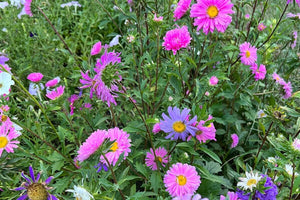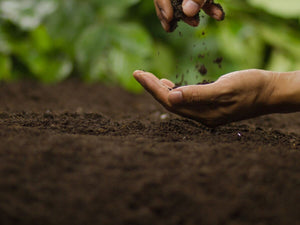Get Growing! Essential May Gardening Tasks for a Thriving Garden
May is one of the most exciting months in the garden—flowers are blooming, veggies are growing fast, and there’s no shortage of things to do outdoors. With more days of nice weather, we love spending time in the garden. Wondering what chores to focus on now? Take a look at this checklist for May gardening tasks.

May flowers, anyone? This is the month to get those warm-weather crops in the ground. Here at Sow Right Seeds, we usually put out our tomatoes, peppers, and flowers in May. The seedlings have been in the grow station waiting for the weather to warm up. By the end of April and the first few weeks of May, we’ve had enough nice days to harden off seedlings before transplanting.
May is when we see a big difference between the cool weather gardens and the warmer ones. Gardeners in the Midwest, like us, are just getting things in the ground, while others in warmer climates are already pulling out their cool-weather crops to get the heat-loving varieties in.
Here's a breakdown of the main gardening tasks to do in May:

May Garden Tasks for Cool Climates
Check your soil temperature and make sure it’s warm enough for those warm-weather seeds to germinate. You can also cover your garden with black plastic to help the soil warm up faster. Check your seed packets for temperature recommendations.
Planning & Prepping
Harden off seedlings. Take time to make sure your tender plants are ready for transplanting after the last frost.
Garden Journal. Write down what you’re doing and when so that you will know what to do next year.
Stake or cage plants like tomatoes and tall flowers.
Mulch beds to retain moisture and suppress weeds once the soil has warmed.

Planting
Herbs such as basil, cilantro, and dill can be direct sown or transplanted.
Warm-season vegetables can be planted or transplanted after your last expected frost (typically mid to late May). These include tomatoes, peppers, cucumbers, squash, beans, and corn.
Quick-growing crops like radishes, lettuce, carrots, beets, and herbs can be direct sown.
Hardened-off seedlings of brassicas, onions, and leafy greens can be transplanted.
Annual flowers like cosmos, zinnias, marigolds, and nasturtiums can be sown once the soil has warmed.
Garden Maintenance
Deadhead spring bulbs (like tulips and daffodils) once blooms fade but leave the foliage to feed the bulb.
Pinch back herb seedlings like basil for bushier growth.
Weed regularly —they grow fast in warm, moist soil.
Thin seedlings to give the remaining plants space to grow.
Check soil moisture daily —young plants and transplants need consistent watering.
Begin fertilizing with compost or balanced fertilizer as plants become established.
Compost kitchen scraps and garden waste to build soil health.
Scout for pests like aphids, cabbage worms, and slugs. Use row covers or organic sprays as needed.
Encourage beneficial insects by planting pollinator-friendly flowers.

Harvesting
Begin early harvests of spring-planted radishes, lettuce, and Swiss chard
Harvest perennial herbs like oregano, chives, and thyme.
May Garden Tasks for Warmer Climates
In warmer climates, the list of garden tasks starts to shift from planting to maintaining and harvesting. Pulling weeds and checking for bugs are worth the time and effort now for a better harvest.
Planning & Prepping
Review your garden journal. How does this year compare? Make notes about changes you want to make.
Seed inventory. Are there seeds you need to replenish before your fall garden season?

Planting
-
Continue planting warm-season vegetables like okra, eggplant, melons, pumpkins, and sweet potatoes.
Succession plant beans, corn, squash, and herbs for a continuous harvest.
Direct sow heat-loving flowers like sunflowers, cosmos, and zinnias.
Garden Maintenance
Thin seedlings and stake tomatoes or vining crops before they get unruly.
Mulch beds to keep the soil cool and conserve moisture.
Fertilize heavy feeders like tomatoes and squash. (link to blog)
Water deeply and consistently, especially in dry or windy areas.
Side-dress with compost or fertilizer to support rapid plant growth
Disease prevention. Watch for early signs of blight or powdery mildew.
Control pests like squash bugs, aphids, and flea beetles with organic methods. Watch for vine borers.
Encourage pollinators by planting marigolds, nasturtium, and native flowers.

Harvesting
Begin harvesting early summer crops like carrots, green beans, and strawberries.
Prune herbs. Basil, cilantro, and other herbs need regular pruning to keep them from going to seed.
We love May gardening. It’s full of hope, as well as a few early-season successes. Let us know what you’re doing in your May garden.
Popular Posts
-

How to Grow Aster Flowers to Star in Your Summer & Fall Garden
-

How to Amend Sandy Soil and Start Growing!






Leave a comment